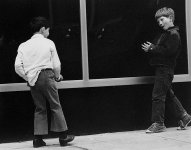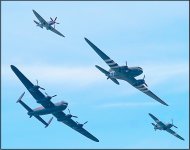- Messages
- 7,918
- Name
- Dave
- Edit My Images
- No
In the inspirational videos thread the overlaying of various aids for composition came up. Then I saw a series starting on Youtube that was about how to compose pictures. It seems that when it comes to trying to help people compose photos it always involves drawing lines over examples, often grids. My tongue in cheek theory is that you can overlay the popular grids on any random picture and a justification for one of them can usually be found!
More seriously I'm not sure how this helps anyone. Nor do I believe good photographers use these tools consciously, particularly when taking photos of anything that is in a state of flux.
One of the recent videos was fitting a certain grid to a picture which ,IMO, was badly framed. Sure all the lines coincided with the subject details, but the overall picture was out of balance. And this is where I think the grid approach falls down. You have to arrange the whole picture space, not just the individual elements within it.
Here is one picture selected at random from one of my collections with Lightroom 'aids' laid over. With a bit of imagination I think you can justify any of them as 'fitting'. I had none of them in mind when taking the photo.
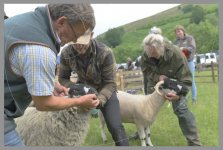
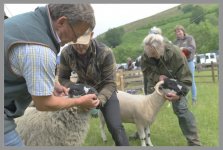
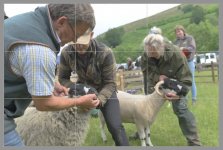
What this kind of thing does is ignore important aspects of picture making. In this example it pays no attention to how we notice where people are looking and follow their gaze. The judge's gaze leads us to the sheep's head, the OOF woman in the background's gaze leads us into the picture preventing our eye wondering out of the right hand side of the frame
What I do quite often to judge if a picture is going to 'work' is to squint so what I see in the viewfinder goes blurry. This stops me looking at details and helps me see the overall arrangement of shapes in the frame. I spent about a year before my cataract operation being unable to focus on the viewfinder image and my pictures didn't suffer at all!
In stead of dropping grids over your pictures I'd like to suggest some 'tricks' I learned as a student to help you look at pictures you've taken with fresh eyes, so as not to get caught up in what you think you've shot.
First of all you can do the squinting thing looking at a picture on a screen or at a print. The next are easier with prints, but can be done digitally. One is to turn the picture upside down. Rotate it in an processing/editing program. Another is to reverse the image. With prints that means looking at its reflection in a mirror. It's surprising how different pictures can look when you do this. You can combine two or more of these tricks if you like. (If you are a ground glass screen viewer you'll already be doing this!) The idea is to see how the picture space is arranged as a whole.
The best way to learn how to make pictures, arrange the picture space, or compose pictures is to look at lots of good ones and soak up what works in them. Paintings and examples of other graphic arts, not just photographs. You don't have to understand what's going on, only recognise it when you see it in the viewfinder. The old advice about always checking the edges of the frame is good, but looking at the whole picture is what it's all about.
Of course there's a lot more to making pictures that 'work' than this, often subject dependent. Gesture and expression, even micro-gesture, are important in people pictures for example. Not normally thought of in terms of composition, but important in making pictures of people. Enough!
I'll just wanted to get this off my chest after shouting at Youtube.
More seriously I'm not sure how this helps anyone. Nor do I believe good photographers use these tools consciously, particularly when taking photos of anything that is in a state of flux.
One of the recent videos was fitting a certain grid to a picture which ,IMO, was badly framed. Sure all the lines coincided with the subject details, but the overall picture was out of balance. And this is where I think the grid approach falls down. You have to arrange the whole picture space, not just the individual elements within it.
Here is one picture selected at random from one of my collections with Lightroom 'aids' laid over. With a bit of imagination I think you can justify any of them as 'fitting'. I had none of them in mind when taking the photo.



What this kind of thing does is ignore important aspects of picture making. In this example it pays no attention to how we notice where people are looking and follow their gaze. The judge's gaze leads us to the sheep's head, the OOF woman in the background's gaze leads us into the picture preventing our eye wondering out of the right hand side of the frame
What I do quite often to judge if a picture is going to 'work' is to squint so what I see in the viewfinder goes blurry. This stops me looking at details and helps me see the overall arrangement of shapes in the frame. I spent about a year before my cataract operation being unable to focus on the viewfinder image and my pictures didn't suffer at all!
In stead of dropping grids over your pictures I'd like to suggest some 'tricks' I learned as a student to help you look at pictures you've taken with fresh eyes, so as not to get caught up in what you think you've shot.
First of all you can do the squinting thing looking at a picture on a screen or at a print. The next are easier with prints, but can be done digitally. One is to turn the picture upside down. Rotate it in an processing/editing program. Another is to reverse the image. With prints that means looking at its reflection in a mirror. It's surprising how different pictures can look when you do this. You can combine two or more of these tricks if you like. (If you are a ground glass screen viewer you'll already be doing this!) The idea is to see how the picture space is arranged as a whole.
The best way to learn how to make pictures, arrange the picture space, or compose pictures is to look at lots of good ones and soak up what works in them. Paintings and examples of other graphic arts, not just photographs. You don't have to understand what's going on, only recognise it when you see it in the viewfinder. The old advice about always checking the edges of the frame is good, but looking at the whole picture is what it's all about.
Of course there's a lot more to making pictures that 'work' than this, often subject dependent. Gesture and expression, even micro-gesture, are important in people pictures for example. Not normally thought of in terms of composition, but important in making pictures of people. Enough!
I'll just wanted to get this off my chest after shouting at Youtube.

 (it wasn't available in English when I was a student so I missed out at the time).
(it wasn't available in English when I was a student so I missed out at the time).